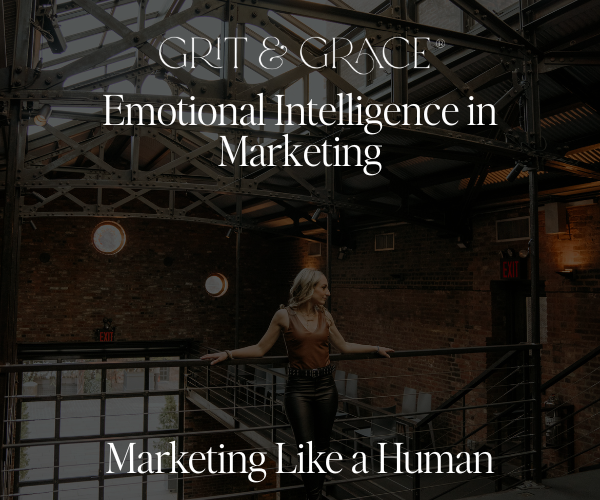Let’s be real for a sec.
If your marketing sounds like a ChatGPT prompt and feels like a copy-pasted carousel, your audience has already scrolled past. The internet is full of noise. Everyone’s chasing the next algorithm hack, automation tool, or viral format and wondering why nothing sticks. Emotional intelligence in marketing is something we don’t think about enough.
But here’s the thing no one’s talking about:
You can’t out-strategize emotional disconnection.
And that’s why emotional intelligence in marketing isn’t just a soft skill, it’s a power move.It’s how you go from posting content to building connection. From “I need engagement” to “I have trust.” From chasing clients to magnetizing them. Because your audience doesn’t buy when they understand you. They buy when they feel understood.

What Emotional Intelligence Actually Means in Marketing
Let’s strip it back no corporate buzzwords, no fluffy definitions.
Emotional intelligence (EQ) is your ability to understand, feel, and respond to emotions your own and your audience’s in a way that builds trust.
In marketing, it looks like:
- Knowing the why behind what you say not just repeating trends.
- Reading between the lines of client feedback.
- Recognizing when your audience needs reassurance, not another pitch.
- Balancing empathy with boundaries.
And it’s not about manipulating emotion it’s about mastering it.
High-EQ marketers understand that every message, caption, and offer triggers a micro-emotion.
Curiosity. Relief. Desire. Safety.
Your job isn’t to scream louder it’s to speak to the emotion that makes someone stop scrolling.
Why Emotion Beats Strategy (Almost Every Time)
Most brands overcompensate with strategy because they don’t trust their emotional instincts.
They build systems, funnels, and content calendars but the message still falls flat.
Why? Because strategy without emotional intelligence is like makeup without skincare.
It might look good for a while, but underneath? It’s cracking.
Here’s the truth bomb:
People don’t follow brands because of perfect design or flawless captions.
They follow the ones that get them.
When you weave emotional intelligence into your marketing, you stop performing for your audience and start partnering with them. You’re not just a business anymore you’re a brand they trust.
How to Use Emotional Intelligence to Strengthen Every Part of Your Marketing
1. Messaging: Speak Human, Not Hype
Before posting, check your tone.
Are you speaking like a peer or a professor?
High-EQ messaging skips the jargon and talks like you’re explaining it to your best friend.
It replaces “streamline your brand strategy for optimized impact” with “let’s make your marketing make sense again.” Human wins every time.
2. Copywriting: Evoke, Don’t Explain
Facts inform, emotions convert. If your copy reads like a checklist, it’s time to inject feeling. Use sensory language. Ask emotional questions. Write from experience.
Instead of: “We offer custom design services.”
Say: “We turn your ideas into visuals that stop the scroll and make people say, ‘That’s so you.’”
See the difference? That’s EQ in action.
3. Content Strategy: Emotion-First Frameworks
Before you decide what to post, decide how you want people to feel.
Each piece of content should have one core emotion driving it:
- Inspiration
- Relief
- Confidence
- Curiosity
- Validation
Then reverse engineer your message to support that emotion.
Emotion → Story → Strategy → CTA.
That’s the Grit & Grace formula.
4. Launching: Lead With Connection, Not Urgency
Scarcity doesn’t sell anymore safety does. People buy when they feel grounded, seen, and supported. When you use emotional intelligence during a launch, you don’t just create buzz you create belonging.
Try this instead of “cart closes soon!”:
“If this offer has been whispering to you, this is your sign to finally say yes. I’ll be right there with you.”
Same urgency. More humanity.
5. Client Experience: The EQ Advantage
Emotional intelligence doesn’t stop at marketing it continues through delivery.
The way you handle feedback, the tone in your onboarding emails, the patience in your revisions it all becomes your brand equity.
When you treat clients like partners instead of transactions, your marketing stops needing to scream.
Your reputation does the talking for you.
🖤 That’s what emotional authority looks like.
Your Emotional Intelligence Action Plan
Let’s make it tangible. Here’s how to build your EQ muscle as a marketer:
Weekly
- Review your analytics and your DMs.
Look for feelings, not just metrics. What’s the tone of your audience? - Journal one honest emotion you felt in business that week.
Awareness starts with you.
Monthly
- Do a “content tone check.”
Does your messaging sound confident, grounded, and consistent with your brand energy? - Collect client stories. Emotion lives in their words use them (with permission) to strengthen your messaging.
Quarterly
- Audit your sales process. Where are you forcing instead of flowing?
- Run a mini brand pulse survey. Ask:
“How does my brand make you feel?”
Those answers are pure gold.
Real Talk: Emotion Is the Future of Marketing
The internet is about to drown in AI-written everything.
And while everyone else is obsessing over automation, the brands that will win are the ones that sound like humans.
You don’t need more posts.
You need more presence.
Emotional intelligence in marketing doesn’t mean you stop being strategic it means you stop being robotic.
It’s not weakness. It’s awareness.
It’s not manipulation. It’s mastery.
Because when you understand emotion, you understand action. And that’s where real conversion lives.

Final Word
Marketing like a human is the difference between attention and affection.Anyone can grab attention.
Few brands earn affection. If your audience feels something when they see your content you’ve already won.
So next time you sit down to plan your content, skip the viral hooks and ask one question:
“How do I want them to feel after reading this?”
That’s not fluff. That’s strategy.
That’s emotional intelligence.
That’s the Grit & Grace way. 🖤
Need help making sure you nail talking like a human every time? Let’s chat!
Read the Comments +